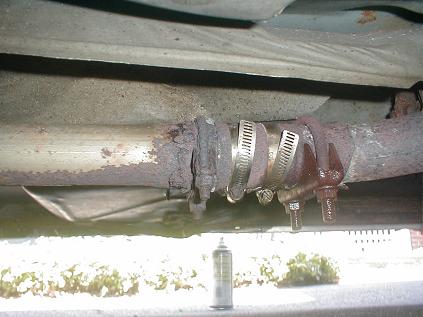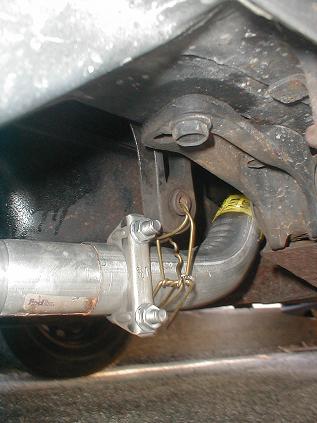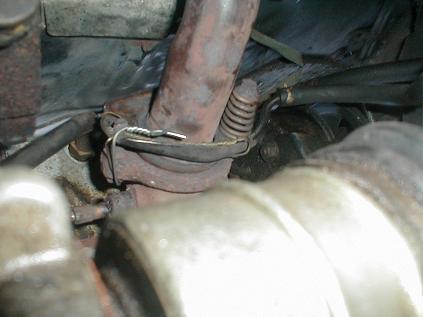|
The Omni Project
If It Jams Home
|
|
I don't see the point of showing step-by-step instructions for clamping together
new pipes, so I'm going to focus on the kludges that kept the old exhaust
system going for a decade. For starters, we have the famous tin can. The
tin can in the picture to the right is wrapped over the pipe at a typical
failure point, between the pipe welded to the catalytic converter (original
24 year old equipment) and the mid-pipe.There are two pipe clamps in the
picture, the big rusty clams to the outside, which held an adapter in place.
The adapter made up the distance left by the old end of the mid-pipe rusting
off. When that adapter rusted through, I wrapped it with a tin can in 2007,
muffler cement underneath, and put on the two aircraft clamps - most people
call them hose clamps. They turned out to be excellent quality, never rusted.
The repair lasted three years, not the three months some fools think you
are luck to get with a tin can. The secret is using a thick walled tin can,
cutting off the ends, and wrapping it around tightly over muffler cement.
|

|

|
To the left you see the rusted out muffler which failed at the seam, and
motivated me to finally replace everything south of the catalytic converter
for the first time in ten years or so. There's no intake pipe on the muffler
because it rotted out completely last year and got wrapped in another tin
can. That can barely aged at all in a year. The pipes themselves remained
strong in the stretches where they weren't clamped, took a few minutes with
a three pound sledge to flatten out the pipe at the curves so it could be
bent into a single piece a few feet long. This particular system requires
four pipe clamps: one between the catalytic pipe and the intermediate pipe,
one for the clamp style hanger at the bend in the intermediate pipe, one
between the intermediate pipe and the tail pipe, and one between the tail
pipe and the muffler intake. The muffler is hung from the back with a bolt
through the bracket mounted on the muffler.
|
|
To the right we have the old exhaust system and the new exhaust system. It's
always a good idea to lay them side by side before installing to find out
if the replacement pipes are an exact match. If they aren't, just bring them
back and reorder. There are few car jobs more miserable than putting in a
new exhaust system that won't fit because the pipes are two short or two
long, and the auto parts stores don't like taking them back after they've
been clamped and are useless. Which is a good time to point out that getting
the right size clamps is critical to have a quiet exhaust system. When I
picked these pipes up at AutoZone, the counter guy measured them with calipers
and declared I needed 2" clamps. That didn't sound right, but he measured,
so I took it all home, but when I went to put it together, they felt a little
sloppy. I took them back and asked for 1-7/8" clamps, which they didn't have.
So I went to NAPA, got the guy to look them up, they were 1-7/8" clamps,
and they fit perfectly.
|

|

|
Unfortunately, with this brand new system and brand new clamps and pipes,
I still needed a kludge. The reason is shown in the picture to the left.
The original hanger was designed for a 1-7/8" clamp with one long leg, like
an extra inch long. The long leg fits through the metal bushing in the rubber
hanger (steel washers on both sides) and it suspends the pipe while clamping
the intermediate pipe to the tail pipe. But the special clamp isn't an auto
parts store stock item and I didn't want to wait for a special order, so
I kept the bushing and the washers and wired it up with a coat hanger. Imagine,
a brand new exhaust system with a coat hanger kludge. While the camera angle
is a little deceptive here, I did hang it about a half inch too low. But
my real ambition is to order up the special clamp sometime and just put it
on right next to the clamp that's actually holding the pipes together.
|
|
So, with all the clamps installed and tightened, I fired up the engine and
it roared like there was no muffler, no pipes, like I was running an open
header. What had happened is my old kludge wiring up the flange on the exhaust
manifold gooseneck had failed, so the steel donut dropped a little and the
manifold was open to the world. The problem is I broke one of the manifold
bolts like fifteen years ago doing some other job I don't remember and couldn't
get the stud out. You'd think they would use a bolt, but it's a welded stud,
or a bolt rust-welded in place. So I wired it, and during the current job,
the weight of the catalytic must have stretched the wire, even though I tried
to support it with a couple of bricks. After wasting a couple hours trying
to come up with a better kludge, I just rewired it with a little galvanized
wire and hopefully it will last another fifteen years.
|

|
|

